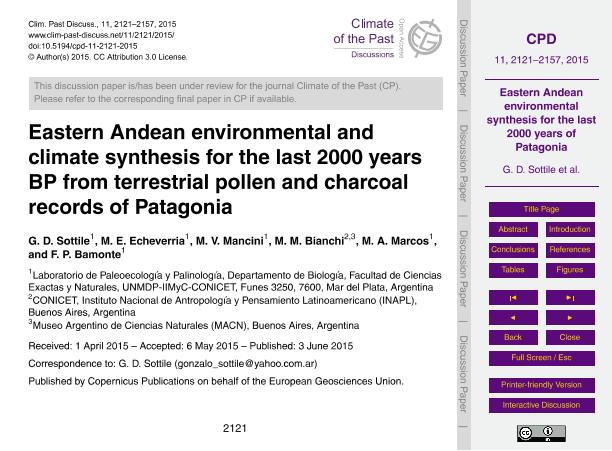Artículo
Eastern Andean environmental and climate synthesis for the last 2000 years BP from terrestrial pollen and charcoal records of Patagonia
Sottile, Gonzalo David ; Echeverria, Marcos Emanuel
; Echeverria, Marcos Emanuel ; Mancini, Maria Virginia; Bianchi, M. M.; Marcos, Maria Alejandra
; Mancini, Maria Virginia; Bianchi, M. M.; Marcos, Maria Alejandra ; Bamonte, Florencia Paula
; Bamonte, Florencia Paula
 ; Echeverria, Marcos Emanuel
; Echeverria, Marcos Emanuel ; Mancini, Maria Virginia; Bianchi, M. M.; Marcos, Maria Alejandra
; Mancini, Maria Virginia; Bianchi, M. M.; Marcos, Maria Alejandra ; Bamonte, Florencia Paula
; Bamonte, Florencia Paula
Fecha de publicación:
03/06/2015
Editorial:
Copernicus Publications
Revista:
Climate of the Past
ISSN:
1814-9324
e-ISSN:
1814-9332
Idioma:
Inglés
Tipo de recurso:
Artículo publicado
Clasificación temática:
Resumen
The Southern Hemisphere Westerly Winds (SWW) constitutes an important zonal circulation system that dominates the dynamics of Southern Hemisphere mid-latitude climate. Little is known about climatic changes in the Southern South America in comparison to the Northern Hemisphere due to the low density of proxy records, and adequate chronology and sampling resolution to address environmental changes of the last 2000 years. Since 2009, new pollen and charcoal records from bog and lakes in northern and southern Patagonia at the east side of the Andes have been published with an adequate calibration of pollen assemblages related to modern vegetation and ecological behaviour. In this work we improve the chronological control of some eastern Andean previously published sequences and integrate pollen and charcoal dataset available east of the Andes to interpret possible environmental and SWW variability at centennial time scales. Through the analysis of modern and past hydric balance dynamics we compare these scenarios with other western Andean SWW sensitive proxy records for the last 2000 years. Due to the distinct precipitation regimes that exist between Northern (40?45◦ S) and Southern Patagonia (48?52◦ S) pollen sites locations, shifts on latitudinal and strength of the SWW results in large changes on hydric availability on forest and steppe communities. Therefore, we can interpret fossil pollen dataset as changes on paleohydric balance at every single site by the construction of paleohydric indices and comparison to charcoal records during the last 2000 cal yrsBP. Our composite pollen-based Northern and Southern Patagonia indices can be interpreted as changes in latitudinal variation and intensity of the SWW respectively. Dataset integration suggests poleward SWW between 2000 and 750 cal yrsBP and northward-weaker SWW during the Little Ice Age (750?200 cal yrsBP). These SWW variations are synchronous to Patagonian fire activity major shifts. We found an in phase fire regime (in terms of timing of biomass burning) between northern Patagonia Monte shrubland and Southern Patagonia steppe environments. Conversely, there is an antiphase fire regime between Northern and Southern Patagonia forest and forest-steppe ecotone environments. SWW variability may be associated to ENSO variability especially during the last millennia. For the last 200 cal yrs BP we can concluded that the SWW belt were more intense and poleward than the previous interval. Our composite pollen-based SWW indices show the potential of pollen dataset integration to improve the understanding of paleohydric variability especially for the last 2000 millennial in Patagonia.
Archivos asociados
Licencia
Identificadores
Colecciones
Articulos(CCT - MAR DEL PLATA)
Articulos de CTRO.CIENTIFICO TECNOL.CONICET - MAR DEL PLATA
Articulos de CTRO.CIENTIFICO TECNOL.CONICET - MAR DEL PLATA
Articulos(IIMYC)
Articulos de INSTITUTO DE INVESTIGACIONES MARINAS Y COSTERAS
Articulos de INSTITUTO DE INVESTIGACIONES MARINAS Y COSTERAS
Articulos(MACNBR)
Articulos de MUSEO ARG.DE CS.NAT "BERNARDINO RIVADAVIA"
Articulos de MUSEO ARG.DE CS.NAT "BERNARDINO RIVADAVIA"
Citación
Sottile, Gonzalo David; Echeverria, Marcos Emanuel; Mancini, Maria Virginia; Bianchi, M. M.; Marcos, Maria Alejandra; et al.; Eastern Andean environmental and climate synthesis for the last 2000 years BP from terrestrial pollen and charcoal records of Patagonia; Copernicus Publications; Climate of the Past; 11; 3-6-2015; 2121-2157
Compartir
Altmétricas



